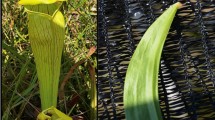Abstract
Interspecific competitive interactions among sessile epibenthos were studied by suspending PVC panels at Tomioka Bay, south Japan, for a maximum period of 16 mo. Interactions were monitored from photographs of a fixed area of the panels. Four panels were suspended during two different months in autumn 1991, and the development of the community was followed until December 1992. Altogether, 6511 interspecific overgrowth interactions were recorded, of which 37 resulted in standoffs and the rest in overgrowths. The competitive relationship observed in this sessile assemblage followed the pattern of a hierarchy with numerous backloops. Among the 36 species, belonging to the seven taxonomic groups encountered during the study, the colonial ascidian Didemnum moseleyi was recorded as the dominant species (with respect to competitive ability) while the barnacle Balanus trigonus was the weakest species. The month of panel exposure and whether or not the panel surface was shaded had a significant influence on the competitive ability of the sessile organisms. The order of hierarchy of the most dominant species changed with the month of panel submersion and its light conditions. Among the several abundant species tested, longer residence times were recorded for serpulid worms than for the colonial species. A significant, positive relationship was obtained between the areal cover of competitively dominant sessile organisms and the number of their interspecific interactions. From the short residence time of sessile organisms and the significant relationship between their areal cover and number of interspecific interactions, it is concluded that the interspecific interactions played important role in the species succession.
Similar content being viewed by others
References
Buss LW (1990) Competition within and between encrusting clonal invertebrates. Trends Ecol Evol 5:352–356
Connell JH (1961) Effects of competition, predation by Thais lapillus, and other factors on natural populations of the barnacle Balanus balanoides. Ecol Monogr 31:61–104
Connell JH (1975) Some mechanisms producing structure in natural communities: a model and evidence from natural communities. In: Cody ML, Diamond J (eds) Ecology and evolution of communities. Belknap, Cambridge, Massachusetts, USA, pp 460–490
Crisp DJ (1984) Overview of research on marine invertebrate larvae, 1940–1980. In: Costlow JD, Tipper RC (eds) Marine bideterioration an interdisciplinary study. Naval Institute Press, Annapolis, Maryland, pp 103–126
Crisp DJ, Ghobashy AFAA (1971) Response of the larvae of Diplosoma listerianum to light and gravity. Proc 4th Eur mar Biol Symp 443–465 [DJ Crisp (ed) Cambridge University Press, Cambridge]
Dayton PK (1971) Competition, disturbance and community organization: the provision and subsequent utilization of space in a rocky intertidal community. Ecol Mongr 41:351–389
Jackson JBC (1977) Competition on marine hard substrata: the adaptive significance of solitary and colonial strategies. Am Nat 111:743–767
Jackson JBC (1979) Overgrowth competition between encrusting cheilostome ectoprocts in a Jamaican cryptic reef environment. J Anim Ecol 48:805–823
Jackson JBC (1983) Biological determinants of present and past sessile animal distributions. In: Tevesz MJS, McCall TL (eds) Biotic interactions in recent and fossil benthic communities. Plenum Press, New York, pp 39–120
Jackson JBC (1984) Ecology of cryptic coral reef communities. III. Abundance and aggregation of encrusting organisms with particular reference to cheilostome bryozoa. J exp mar Biol Ecol 75: 37–57
Jackson JBC, Buss LW (1975) Allelopathy and spatial competition among coral reef invertebrates. Proc natn Acad Sci USA 72: 5160–5163
Kawahara T (1969) Studies on the marine fouling communities. IV. Differences in the constitution of fouling communities according to localites. a. Nagasaki Harbor. Rep Fac Fish prefect Univ Mie 6:109–125
Lopez Gappa JJ (1989) Overgrowth competition in an assemblage of encrusting bryozoans settled on arteficial substrata. Mar Ecol Prog Ser 51:121–130
Nandakumar K (1993) Interspecific interactions among subtidal sessile organisms. Ph.D. thesis, Kyushu University, Japan (unpublished)
Nadakumar K, Tanaka M (1993) Interspecific copmetition for space among sessile invertebrates: a review. Publs Amakusa mar Biol Lab 12: 13–35
Nandakumar K, Tanaka M, Kikuchi T (1993) Interspecific competition of fouling organisms in Tomioka Bay, Japan. Mar Ecol Prog Ser 94:43–50
Osman RW (1978) The influence of seasonality and stability on the species equilibrium. Ecology 59:383–399
Quinn JF (1982) Competitive hierarchies in marine benthic communities. Oecologia 54:129–135
Rubin JA (1985) Mortality and avoidance of competetive overgrowth in encrusting bryozoa. Mar Ecol Prog Ser 23:291–299
Russ GR (1982) Overgrowth in a marine epifaunal community: competitive hierarchies and competitive networks. Oecologia 53: 12–19
Schmidt GH, Warner GF (1986) Spatial competition between colonial ascidians: the importance of stand-off. Mar Ecol Prog Ser 31:101–104
Schoener A (1974) Experimental zoogeography: colonization of marine mini islands. Am Nat 108:715–738
Sebens KP (1985) Community ecology and subtidal rock walls in the Gulf of Maine, USA: small scale process and alternative community states. In: Moore PG, Seed R (eds) The ecology of rocky coasts. Hodder & Stoughton Educational, Sevenoaks, Kent, England, pp 346–371
Sebens KP (1986) Spatial relationships among encrusting marine organisms in the New England subtidal zone. Ecol Mongr 56:73–96
Smedes GW (1984) Seasonal changes and fouling community interactions. In: Costlow JD, Tipper RC (eds) Marine biodeterioration and interdisciplinary study. Naval Inst Press, Annapolis, Maryland, pp 155–160
Sokal RR, Rohlf EJ (1987) Introduction to biostastistics, 2nd edn. WH Freeman & Co., New York
Stebbing ARD (1973) Competition for space between the epiphytes of Fucus serratus L. J mar biol Ass UK 53:247–261
Sutherland JP, Karlson RH (1977) Development and stability of the fouling community at Beaufort, North Carolina. Ecol Monogr 47: 425–446
Todd CD, Turner SJ (1988) Ecology of intertidal and sublittoral cryptic epifaunal assemblage. II. Nonlethal overgrowth of encrusting bryozoans by colonial ascidians. J exp mar Biol Ecol 115: 113–126
Author information
Authors and Affiliations
Additional information
Communicated by T. Ikeda, Nagasaki
Rights and permissions
About this article
Cite this article
Nandakumar, K. Competitive interactions among sessile organisms in Tomioka Bay, south Japan: importance of light conditions on the panel surface. Marine Biology 121, 713–719 (1995). https://doi.org/10.1007/BF00349307
Received:
Accepted:
Issue Date:
DOI: https://doi.org/10.1007/BF00349307




